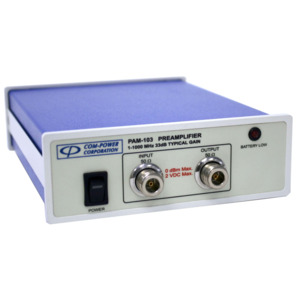
- Description
- Specifications
- Documents
The PAM-103 is a broadband, high gain, low-noise preamplifier operating over the frequency range of 1 MHz to 1 GHz. Its high gain (33 dB ±3 dB) and low noise figure (<3.3 dB) make the PAM-103 Preamplifier the ideal choice for optimising your EMI measurement system, whether it be for an absorber lined test chamber, open area test site or tem-cell.
The PAM-103 can be powered by its internal, rechargeable battery packs, or by its AC to DC Power Adopter/Battery Charger. On a full charge, the preamp will operate on battery power for over 13 hours. The battery low indicator light will let you know when it is time to plug it in; and the charging indicator light will let you know that its charging. If you are unable to plug it in, you can feel confident in continuing your test, as the PAM-103 will turn itself off well before the battery voltage reaches the point at which the gain could become unstable. Whether it’s operating on battery power or external power; if the amp is on, you can rest assured that the output is stable and that the gain will remain constant.
Construction
The durable enclosure for the PAM-103 is designed to withstand years of punishment in any laboratory environment. It is constructed from rugged, high-quality aluminium, with an external powder coat.
Why is a Preamplifier Needed?
Nearly all measurement systems for radiated EMI tests require preamplification in order to achieve the necessary sensitivity. The sensitivity is determined by system noise floor level, which usually appears as a thick ‘fuzz’ across its frequency range. The upper extreme of the ‘fuzz’ represents the bottom end of the instrument’s dynamic range (for the respective instrument bandwidth setting) throughout its frequency range. The noise floor level increases/decreases proportionately (10 dB per decade of bandwidth change Signals below the noise floor level are essentially masked (hidden). In addition, signals with amplitudes near the level of the noise floor typically measure higher than actual. Therefore, for the best measurement accuracy, the noise floor should be as far below the spec limit as is possible.
Signals below the noise floor level are essentially masked (hidden). In addition, signals with amplitudes near the level of the noise floor typically measure higher than actual. Therefore, for the best measurement accuracy, the noise floor should be as far below the spec limit as is possible.
